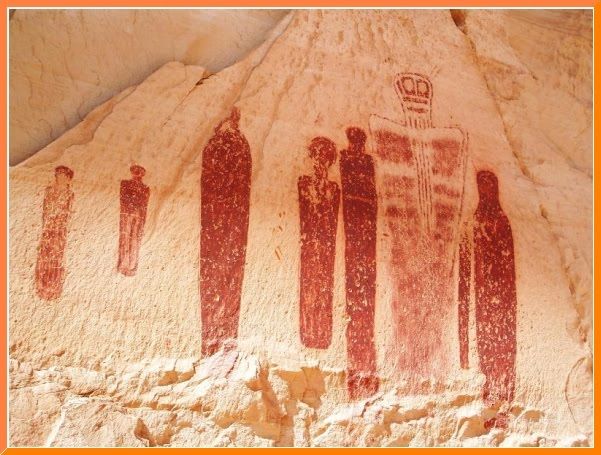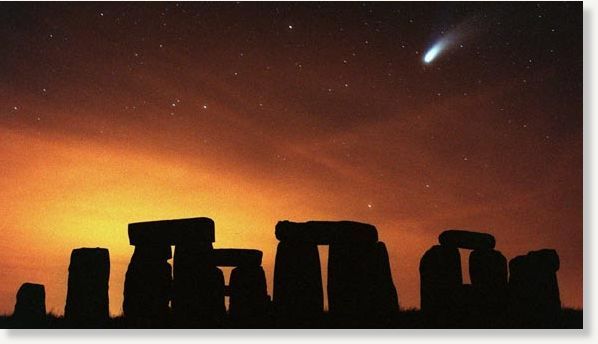
Hale-Bopp over Stonehenge
Update: We covered a list of prophecies in the first part of this series. The idea of California ‘falling into the sea’ was mentioned. Just a few days ago, another chunk of it did just that. Specifically, part of the Paseo del Mar road in San Pedro fell into the Pacific Ocean after a landslide on 21 November. We don’t think this particular landslide is what the Cs were referring to, just thought the timing was interesting in light of bringing it up here!
Just as new discoveries in science can overturn a previously held ‘consensus’ in a heartbeat (often to the consternation or willful disbelief of those promoting the consensus), new historical data can turn our ideas of what we think happened in our history on their head. We often take for granted that event X occurred in year Y, forgetting that either or both of those variables may be completely false. The event may turn out to have been a fiction, created by scribes and leaders of the time (or years later) for purposes of political propaganda. Dating methods may be inaccurate or possess possible confounding factors, mucking up the accepted timeline. Or, when new documents or scientific data are discovered, the event may turn out to bear little resemblance to our previous ideas of how it happened. New actors emerge with new motivations, necessitating a revision of the history books and the way we see the events and personages of our near and distant past.
Then there are the problems inherent in the study of prehistory, before the advent of ‘history’ as we know it. There, we only have scarce clues to rely on, all built on sciences which are themselves built on certain assumptions about the way things work. Archaeology, paleoanthropology, population and molecular genetics, climate science, geology… all of these contribute to a story of the past that historians create for us. When we consider the relatively young age of many of these sciences, the amount of information that we have amassed in that short amount of time is pretty staggering. But it’s important to keep in mind that history too is a work in progress; new theories and advancements in science can prompt a radical revision of old ideas.
Prehistory occupies a good portion of the Cs transcripts. While archaeologists and anthropologists can piece together broad outlines of migrations, genetic mixing, human behaviors, population bottlenecks, etc., this was a period from which no written records appear to have survived. As such, it’s hard to verify specific historical details and much of what the Cs say about these times remains interesting conjecture. But while much of it is unverifiable, it also provides opportunities to test the material as new discoveries come to light: fossil finds, climate studies, evidence for catastrophes and extinctions, and more.
The Caveman Who Wasn’t There
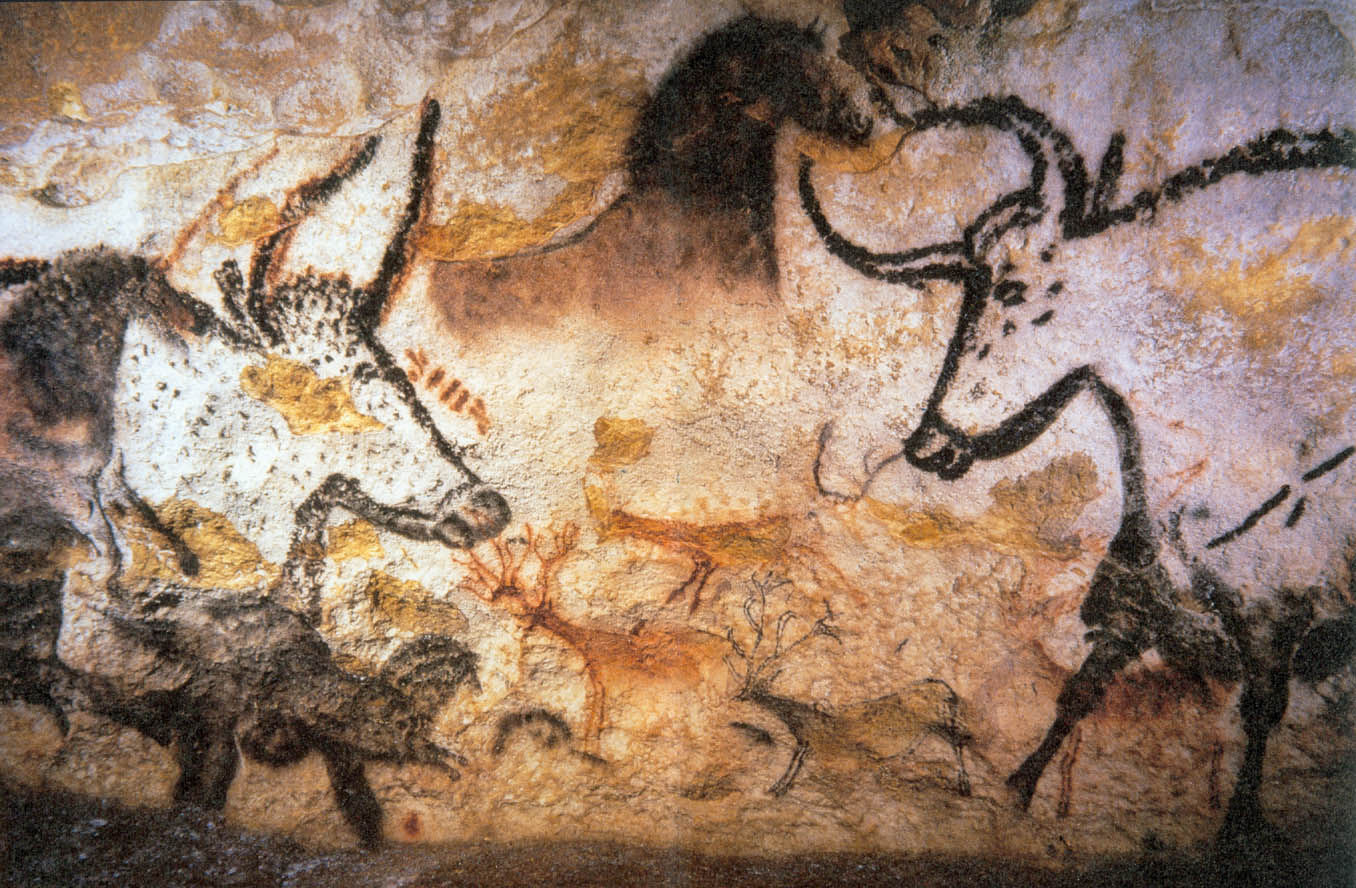
Cave paintings in Lascaux, southwestern France
On 15 April 2000, the following exchange took place on early hominids:
Q: (L) Well, for a period of time it seems that they [Neanderthals] continued to exist on the planet alongside the new model, Cro-Magnon or whatever.
A: Some did.
Q: (L) For how long did Neanderthal exist side by side with the ‘new model’?
A: 233 years.
Q: (L) I thought that Neanderthal was here for a long, long, long time; and if modern man arrived on the planet, as you say, seventy to eighty thousand years ago, wasn’t Neanderthal already here then?
A: Time references have been miscalculated.
For a long time, this remark seemed somewhat unbelievable. After all, according to the experts, Neanderthals existed for almost 200,000 years, finally becoming extinct around 27 to 28,000 years ago. For example, one of the historically latest Neanderthal fossil finds, found in the Zafarraya cave in southern Spain, has been dated to 30,000 years ago (Ian Tattersall and Jeffrey Schwartz, Extinct Humans [New York: Nevraumont, 2001], pp. 176, 219). In contrast, the earliest anatomically and behaviorally modern human remains have been radiometrically dated to about 35 to 40,000 years ago, making for an overlap of several thousand years (Paul Mellars, The Neanderthal Legacy [Princeton: Princeton University Press, 1996], pp. 2, 392). This time period coincides with the so-called ‘Paleolithic Revolution’, during which what we consider to be fully ‘modern’ human behavior exploded onto the scene, as evidenced in the stunning cave art of the Aurignacian period.
However, in May 2011, direct dating of an important Neanderthal fossil threw a monkey wrench into this ‘accepted’ chronology. Science News reported that Dr. Ron Pinhasi and his colleagues “dated a Neanderthal fossil discovered in a significant cave site in Russia in the northern Caucasus, and found it to be 10,000 years older than previous research had suggested.”The article continues:
This new evidence throws into doubt the theory that Neanderthals and modern humans interacted for thousands of years. Instead, the researchers believe any co-existence between Neanderthals and modern humans is likely to have been much more restricted, perhaps a few hundred years. It could even mean that in some areas Neanderthals had become extinct before anatomically modern humans moved out of Africa.
The fossil was dated to 39,700 years old. As the article put it: “This finding challenges previous claims that late Neanderthals survived until 30,000 years ago in the northern Caucasus, meaning that late Neanderthals and modern humans were not likely to experience any significant period of co-existence.” The authors allege that previous dating processes “have ‘systemically underestimated’ the true age of Late Middle Paleolithic and Early Upper Paleolithic deposits, artifacts and fossils by up to several thousand years,” citing sample contamination as one of the main reasons for these errors. Dr. Pinhasi said: “It now seems much clearer that Neanderthals and anatomically modern humans did not co-exist in the Caucasus, and it is possible that this scenario is also true for most regions of Europe.” Any interbreeding (leading to the observable Neanderthal DNA in some humans) most likely occurred very early, possibly in the Middle East during this short time period, according to Pinhasi.
Regarding time references being miscalculated, we’ll get to that in more detail in another installment.
Parenthetical Humanoids
As mentioned in the first installment, the legend of ‘Atlantis’ comes up repeatedly. With its origins in the writings of Plato, Atlantis, according to the Cs, represents an ‘advanced’ civilization during the Paleolithic period (i.e. 300,000 to 10,000 years ago), keeping in mind that ‘advanced’ may not necessarily match with our preconceptions about technology and civilization. While several researchers have collected a lot of research suggesting the existence of such a global civilization in that time period (e.g., Klaus Dona, as well as Christopher Knight and Alan Butler, in recent years), we won’t deal with it here at the moment. However, in one discussion on the topic, on 31 May 1997, the following exchange took place:
Q: As I understand it, Atlantis was already quite a developed civilization at that time [80,000 years ago]. Is that correct?
A: Yes, but regions change with waves of immigration, or conquest … witness your own lands. […] Atlantis was merely a home base of an advanced civilisation of 3 races of humans occupying different sections of a huge Island empire, which, in itself, underwent 3 incarnations over a 100,000-year period as you would measure it.
Q: The 3 races were the Celts [i.e. Indo-Europeans] … and who were the second and third?
A: Or Kantekkians.
Q: Are the Kantekkians different from the Celts?
A: Only in the sense of long term racial and genetic blending.
Q: So, Atlantis had the Kantekkians/Celts and who else?
A: Race you would call “Native Americans,” and a third, no longer existing race, somewhat resembling Australian or Guinean aborigines, only lighter in complexion. [These were the ‘Paranthas’, mentioned earlier in the session.]
Q: Was this third group destroyed by the other two?
A: One of the 3 cataclysms. […]
Q: So, the Paranthas were the antecedents of the Abos of Australia?
A: Yes, and compare to now existing peoples of India, Pakistan, Sri Lanka, Australia, and New Guinea for similarities, bearing in mind genetic mixing and dilution.
Q: Were the Vedas written by the Paranthas or written by the Celts?
A: Descendants of Parantha, as per “Divine guidance.”

DNA recovered from a 40,000 year old pinkie bone found in Russia’s Denisova cave links a newly-described extinct line of Neanderthal-like human ancestors to Melanesian populations of the South Pacific. (© Flickr user 710928003)
On 31 October 2011, Live Science published an article on the so-called ‘Denisovans’, titled ‘Asian Ancestors Had Sex with Mysterious Human Cousins’. The only known fossils of this branch of extinct humans were discovered in 2008 in a cave in Siberia, which include a single tooth and finger bone (and possibly a toe bone, which is currently being studied). Based on genetic tests, the results of which were only published in 2010, the Denisovans’ DNA differs from modern humans’ by 385 base pairs (Neanderthals differ by 202 and chimps by 1,462) and share a common ancestor with Neanderthals. Their DNA can be found in Melanesians and Australian Aborigines today. From the Live Sciencearticle:
Neanderthals weren’t the only ancient cousins that humans frequently mated with, according to a new study which finds that East Asian populations share genes with a mysterious archaic hominin species that lived in Siberia 40,000 years ago. … The Denisovans likely split off from the Neanderthal branch of the hominin family tree about 300,000 years ago, but little else is known about their appearance, behavior or dress. But just as researchers have learned that ancient humans and Neanderthals mated, they’ve also found genetic echoes of the Denisovans in modern residents of Pacific islands, including New Guinea and the Philippines. […]
While Oceanians have about a 5 percent fraction of Denisovan-related ancestry, Southeast Asians have around 1 percent, the researchers report today (Oct. 31) in the journal Proceedings of the National Academy of Sciences. In comparison, genes from modern non-African humans have about a 2.5 percent fraction of Neanderthal ancestry.
It’s hard to tell when the Denisovan and human interbreeding occurred, Jakobsson said, but since Europeans don’t have Denisovan ancestry, it’s likely the mating occurred around 23,000 to 45,000 years ago, after Southeast Asians and European populations diverged.
Jakobsson and his colleagues are working on further studies on early human genetics and the steps that led to the modern human genome. The more digging scientists do, the more complex the genetic picture becomes, he said. Notably, bits of genes are almost all that are left behind of some ancient populations, including the Denisovans, he said.
As for possible Indian connections, paleoanthropologist John Hawks is skeptical, but writes the following:
As a case in point, HLA-A*11 is very common in Papua New Guinea, but it is also very common in north India and in China. These two areas otherwise show no significant evidence of Denisova ancestry. We might conclude that the HLA-A gene just has an unusually high level of introgression into Asian populations, not typical of the genome as a whole. That’s certainly possible. But without finding any substantial number of derived mutations in the HLA-A*11 variant in the Denisova genome and in living Asians, it is hard to rule out that the sharing of HLA-A*11 in all these populations is just coincidence.
In other words, it’s a complex issue and too soon to tell for sure if certain genetic similarities (in this case, a single gene) between the Denisova-descended Southeast Asians and continental Indians are mere coincidence or the result of some Denisovan heritage. Perhaps the Cs offered a clue to this subject when they said: “bearing in mind genetic mixing and dilution.”
Native American Immigrant Song
Moving forward a bit in history, the next possible hit concerns one branch of Native Americans. According to current theories, the first migration of Paleoindians into North America occurred during the last ice age at least 12,000 years ago or earlier – there is still debate about when the first migrations occurred. For example, the Clovis people, believed by many archaeologists to be the first North American inhabitants, were wiped out along with the North American megafauna around the time of the Younger Dryas cold period. They first show up in the archaeological record about 13,500 to 13,000 years ago (with radiocarbon dates of 11,500 years). But there is much evidence for pre-Clovis cultures. See the list of sites at Wikipedia, some of which date back 30,000 to 60,000 years. Recently, in March 2011, it was reported that archaeologists discovered a cache of finds in Texas that were up to 2,500 years older than the earliest evidence for the Clovis peoples. As Dr. Lee Nordt, one of the authors of the study, said:
“This find really rewrites history, so to speak, and changes our collective thought on the early colonization of North, Central and South America […] What sets this study apart is that we were able to show using geological methods that the buried artifacts dating to pre-Clovis times were in their original state. This demonstrates unequivocally that the peopling of the Americas occurred much earlier than previously thought.”
But the Clovis and pre-Clovis people weren’t the only ones to come to inhabit North America. According to Wikipedia, “The Na-Dené people entered North America starting around 8000 BCE, reaching the Pacific Northwest by 5000 BCE, and from there migrating along the Pacific Coast and into the interior. Linguists, anthropologists and archeologists believe their ancestors comprised a separate migration into North America, later than the first Paleo-Indians.”
The languages of the Na-Dené, spoken by groups in Alaska and Canada as well as down the west coast/southwest US (e.g. Navaho and Apache), share similarities with the Yeniseian languages of central Asia (all of which except Ket are now extinct). The distance between these two groups is the largest of any accepted language family. This has led in part to the Sino-Caucasian (Dene-Caucasian) language hypothesis. One part of that hypothesis, specifically the connection just mentioned, has recently gained mainstream acceptance, including a conference dedicated to the topic in 2008. With that said, here’s what the Cs had to say on 7 October 1994:
This picture comes from Horseshoe Canyon, otherwise known as Barrier Canyon in Utah. This seven-foot-high painting stands out among the others because of its size. It is part of the Great Gallery in Horseshoe Canyon, standing nearly life size next to a series of other images. Archeologists have struggled to interpret the strange figures that are depicted on the Great Gallery.
Q: (L) What is the source of the Native American Indians?
A: Asia.
Q: (L) Across the Bering Strait?
A: No. Rescued. Transferred.
Q: (L) By whom?
A: Grays.
Q: (L) What were they rescued out of?
A: Cataclysm.
Q: (L) When did that cataclysm occur?
A: 7200 years ago approx.
Q: (L) What was the nature of that cataclysm?
A: Comets.
Now, check out this diagram. According to lexicostatistical analysis, the time depth from Yeniseian back to its branching off from Dene-Caucasian (from which comes Na-Dene), is just over 7000 years:
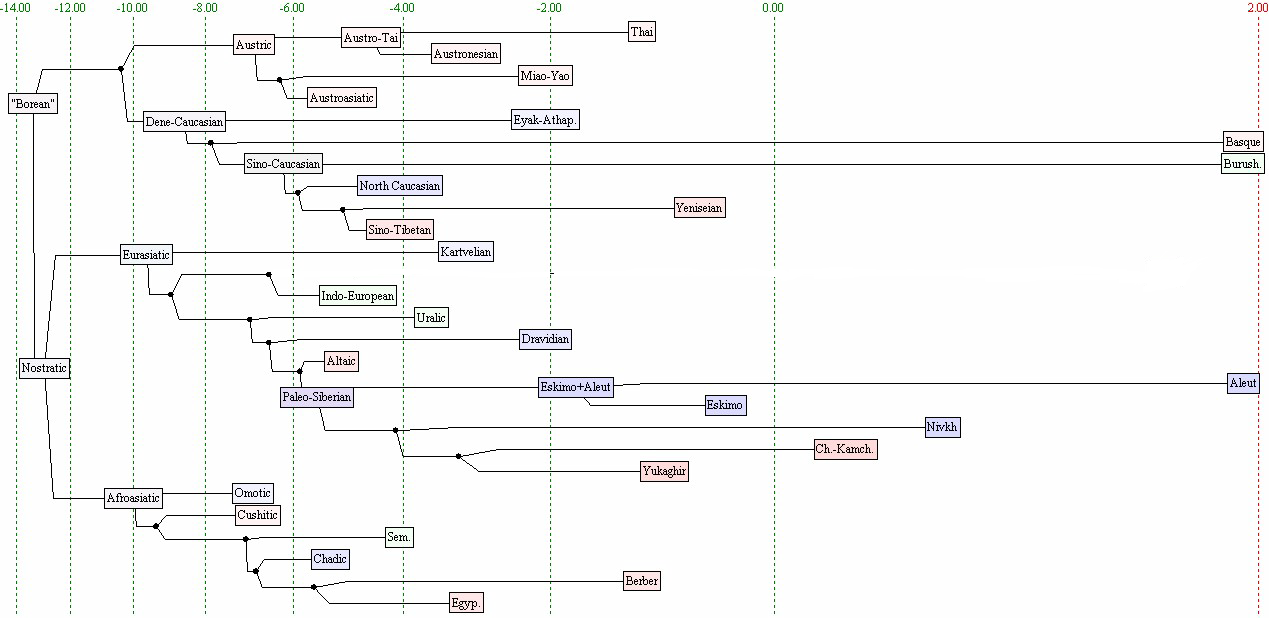
While we haven’t been able to find any evidence indicating a comet encounter in the Yenisei basin at the time indicated (incidentally, this is where the famous Tunguska airburst occurred in 1908), catastrophe has been a prime mover in mass migrations (no pun intended) throughout history, and the unusually large distance between these two language groups is puzzling and suggests something out of the ordinary to account for the branching of these groups. So while the ‘transfer’ idea is at this point mere speculation, it remains ‘interesting’ nonetheless. Keep the 7,200-year figure in mind as we proceed.
Bright Omen, Dark Age
Speaking of comets, the subject of cometary bombardment, both in history and our future, is another that comes up a lot in the Cassiopaean Experiment, and we’ll probably be discussing it frequently along the way. While largely ignored by mainstream academia and media, the phenomenon has great implications for our understanding of history, the rise and fall of empires, and our future, as new research has been showing in recent years.
Moving along to more recent history, these remarks from the session on 12 September 1998 ended up proving to be quite the hit:
Q: (L) I have discovered that three of the supernovas of antiquity which have been discovered and time-estimated by the remnants, occurred in or near Cassiopeia at very interesting points in history.
A: Yes…
Q: (L) Well, one of these periods in history was around 1054. This is a very interesting time. It just so happens that there are no European records of this supernova, which was recorded by the Chinese, Japanese, and perhaps even the Koreans. Yet, there are no European records. What happened to the European records?
A: Europe was in a “recovery mode” at the “time.”
Q: (L) Recovery from what?
A: Loss of civilized structure due to overhead cometary explosion in 564 AD.
Q: (L) What effect did this have on the civilized structure? Was it a direct effect in terms of material, or did it have effects on people causing them to behave in an uncivilized and barbaric way?
A: Well, the burning fragmentary shower ignited much of the land areas in what you now refer to as Western Europe. This had the results you can imagine, causing the resulting societal breakdown you now refer to as “The Dark Ages.”
Q: (L) Well, it damn sure was dark. There is almost a thousand years that nobody knows anything about!
A: Check Irish or Celtic, and French or Gallic records of the era for clues. There were temporary “islands of survival,” lasting just long enough for the written word to eke out.
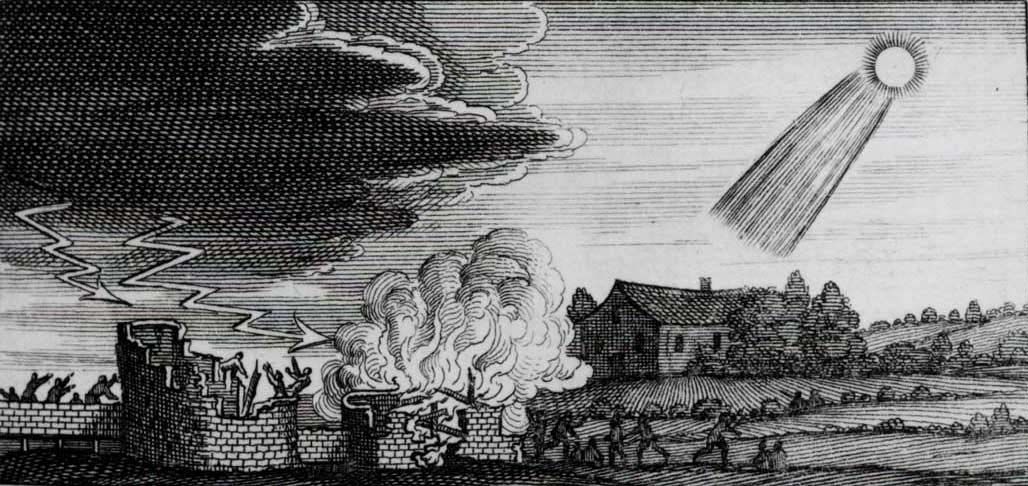
Woodcut showing destructive influence of a comet, dated to the fourth century AD, from Stanilaus Lubienietski's Theatrum Cometicum (Amsterdam, 1668)
A year after this session, on 17 August 1999, the Knight Ridder Washington Bureau published an article by Robert S. Boyd entitled ‘Comets may have caused Earth’s great empires to fall’, which said: “Recent scientific discoveries are shedding new light on why great empires such as Egypt, Babylon and Rome fell apart, giving way to the periodic “dark ages” that punctuate human history. At least five times during the last 6,000 years, major environmental calamities undermined civilizations around the world.“
Comparing the events to the fragments of comet Shoemaker-Levy, which impacted Jupiter with megatons of explosive energy, the researchers say such impacts in earth’s history produced dust clouds that dimmed the Sun, cooled the earth and caused massive crop failure, hunger, disease and death, as plague and famine spread through Italy, China and the Middle East. The previous order disintegrated, leading to the paucity of historical, artistic and cultural remnants for such periods.
The last such global crisis occurred between AD 530 and 540 — at the beginning of the Dark Ages in Europe — when Earth was pummeled by a swarm of cosmic debris. […] Dendrochronologist Mike Baillie established with analysis of tree ring data that in 540 AD, in different parts of the world, the climate changed. Temperatures dropped enough to hinder the growth of trees as widely dispersed as northern Europe, Siberia, western North America, and southern South America.
A search of historical records and mythical stories pointed to a disastrous visitation from the sky during the same period, it is claimed. There was one reference [Roger of Wendover] to a “comet in Gaul so vast that the whole sky seemed on fire” in 540-41.
According to legend, King Arthur died around this time, and Celtic myths associated with Arthur hinted at bright sky Gods and bolts of fire.
In the 530s, an unusual meteor shower was recorded by both Mediterranean and Chinese observers. Meteors are caused by the fine dust from comets burning up in the atmosphere. Furthermore, a team of astronomers from Armagh Observatory in Northern Ireland published research in 1990 which said the Earth would have been at risk from cometary bombardment between the years 400 and 600 AD.
Interestingly, it was a ‘Celtic record’ that gave Baillie the confirmation he needed: the dendrochronological record based on Irish oaks – a continuous 7400-year-long record of tree ring growth drawn from Irish trees – as well as records in the form of myth and legend from the time in question. Additionally, the Irish Annals refer to two ‘bread failures’ during this small time window (famines are also recorded in China, as well as the Justinian plague that spread from Egypt through Europe). (See Baillie, From Exodus to Arthur [Batsford, 1999], p. 78) Here are some of Baillie’s conclusions, from his book The Celtic Gods(Tempus, 2005), co-authored with Patrick McCafferty:
It is possible that many stories about the exploits of saints may simply be Christianised versions of older pagan tales, with Patrick and Columcille replacing Lugh; but there is another option worth considering: perhaps some of these deeds … actually took place during the lifetime of the saints, in the sixth century. This is probably an appropriate point in this book to remind the reader of the similarity between the Irish word for saint (niamh) and the word for the sky or heaven (neamh).
It should be pointed out that, in 540, not only do we have lots of churches founded in Ireland [“foundation sites had traditionally been identified by objects falling from the skies”] by saints who sound remarkably like pagan Celtic Comet gods, but throughout Europe, churches are being established by saints such as St David, St Michael and St George, better known for their skills at vanquishing dragons [a common cometary symbol]. Furthermore, … the entire body of Arthurian legend also takes place at this same time. […]
Altogether, when one considers the expansion of the church, together with the quasi-mythical activities of saints, kings and magicians, and the problems faced by Irish oak trees, it is difficult to resist the conclusion that the skies were indeed busy at this time. (p. 172)
The myths of the Celts are riddled with sky and comet imagery. Not only do we find characters described like comets (and mistakenly seen as sun gods by earlier scholars), but the times of year when the earth passed through the Taurid meteor stream. There are even indications that the ages at which some of the principal characters engage in the main events of their lives reflect the return times of comets coming close to earth. We are convinced that events in the skies do indeed appear in the myths. (p. 175)
Just a Little Bit of History Repeating
Perhaps relating to the figure of 7,200 years mentioned above, the Cs had this to say on 30 September 1994:
Q: (L) Is there any regular periodicity or cycle to this comet business?
A: Yes.
Q: (L) What is the period?
A: 3600 years roughly.
And this on 5 October 1994:
Q: (L) Now, this cluster of comets, when was the last time it came into the solar system?
A: 3582 yrs ago?
Q: (L) What is the cycle?
A: 3600 yrs.
Q: (L) So, when is this cluster expected to hit the plane of the ecliptic again?
A: 12 to 18 years.
If we keep in mind what we have learned from Baillie – that comet bombardments are very likely to be one of the main causes behind the collapse of empires throughout history – we can use this to look for possible markers for this event. Most recently, the following information was published by the Proceedings of the National Academy of Sciences in early 2009, and reported by the Associated Press in an article titled ‘Natural disasters doomed early Peruvian civilization 3,600 years ago’:
Nature turned against one of America’s early civilizations 3,600 years ago, when researchers say earthquakes and floods, followed by blowing sand, drove away residents of an area that is now in Peru. “This maritime farming community had been successful for over 2,000 years, they had no incentive to change, and then all of a sudden, boom, they just got the props knocked out from under them,” anthropologist Mike Moseley of the University of Florida said in a statement.
Not so coincidentally, this matches with another date Baillie has focused on as a possible cometary catastrophe with global effects: 1628 BC. This date appears in ice core data, tree rings across Europe and the Americas, in Babylonian and Chinese records (both of which record possible evidence of a dust veil dimming the skies and cooling the earth), and even one enigmatic reference to catastrophe in the Irish Annals, although the far removal in time between the event and the written record make it difficult to nail down with any certainty (Baillie, 1999, p. 77). This event may also coincide with the fall of the Xia dynasty in China, when a comet was recorded in Chinese records. McCafferty and Baillie (2005, p. 34) write:
c.1600 BC – Chinese record of two suns in the sky [a common description of comets in ancient records], one to the east and one to the west, just before the overthrow of King Chieh and the demise of his Hsia dynasty. Chieh is reported to have said, “When that (the second) sun dies, you and I, we’ll all perish.”
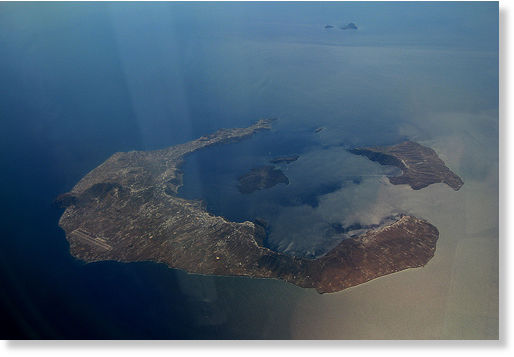
View of Santorini from the air (© Flickr user Σταύρος)
Baillie argues 1628 BC for the true date of the eruption of Santorini, which brought down the Bronze Age Minoan civilization that had thrived for over a millennium and probably coincided with either the beginning or the end of the Second Intermediate period in Egypt (the period of so-called ‘Hyksos’ rule). This was a controversial position to take when it was first proposed in the late 1980s, because it called for a revision of Egyptian chronology, pointing out some of the problems of history mentioned at the beginning of this article. Egyptian chronology is largely dependent on Biblical chronology, which has largely been discredited in recent years. Archaeology, in turn, has largely relied on this ‘established’ chronology to calibrate itself. There are no firmly established anchors or markers with which to calibrate ancient history. Those that are commonly used are actually vague astronomical references that can refer to several different dates, or are too fragmentary to provide any solid date. As archaeologist and historian Colin Renfrew put it in his introduction to Peter James’ book Centuries of Darkness (Rutgers, 1993):
The first step … is to recognize the depths of our ignorance. To realize how the existing ‘chronologies’ in different parts of the Mediterranean are bolstered up by circular arguments, where specialists in one area believe that those in other areas must know what they are talking about, and blindly use dating systems which are no better than their own. (p. xv)
In short, nothing is certain that far back in time, yet the dates we all learn in school and university are taken for granted, even by the professionals. However, most mainstream historians have accepted the date for Santorini in recent years based on the more robust nature of the scientific evidence, as opposed to the imprecise ‘Biblical-chronological’ methods. Santorini could be one such anchor to help calibrate the timeline, but it remains to be seen how far historians will go in their revision of the accepted chronology. Also, historians are increasingly acknowledging climatic factors in explaining the periods of economic affluence and depressions discernible in the historical records for this time. On this subject, historian Thomas L. Thompson writes, with typical academic understatement:
Each successive period – Early Bronze IV, Middle Bronze II/Late Bronze I, Iron I, and the early ‘Persian’ period – finds its fate in economic collapse and a dramatic Malthusian culling of the population. It is these periods that most require historical explanation, for these depressions are departures from the expected. (The Mythic Past [Perseus, 1999], p. 135)
For reference, here are the accepted dates for these periods mentioned by Thompson: Early Bronze IV (2100 BC), Middle Bronze II/Late Bronze I (1550 BC), Iron I (1150 BC). Note that the 1550 BC figure falls within the period under contention in regards to the date of Santorini and its conflict with the previously accepted chronology. (On a related note, a recent radiocarbon analysis of the beginning of the Egyptian New Kingdom pushed it back as many as twenty years, to 1570 BC.) With those dates in mind, here are the dates Baillie has identified as comet-induced global climate catastrophes based on tree-ring data (as well ice core data, historical and archaeological records): 2345 BC, 1628 BC, and 1159 BC. Fascinating, huh?
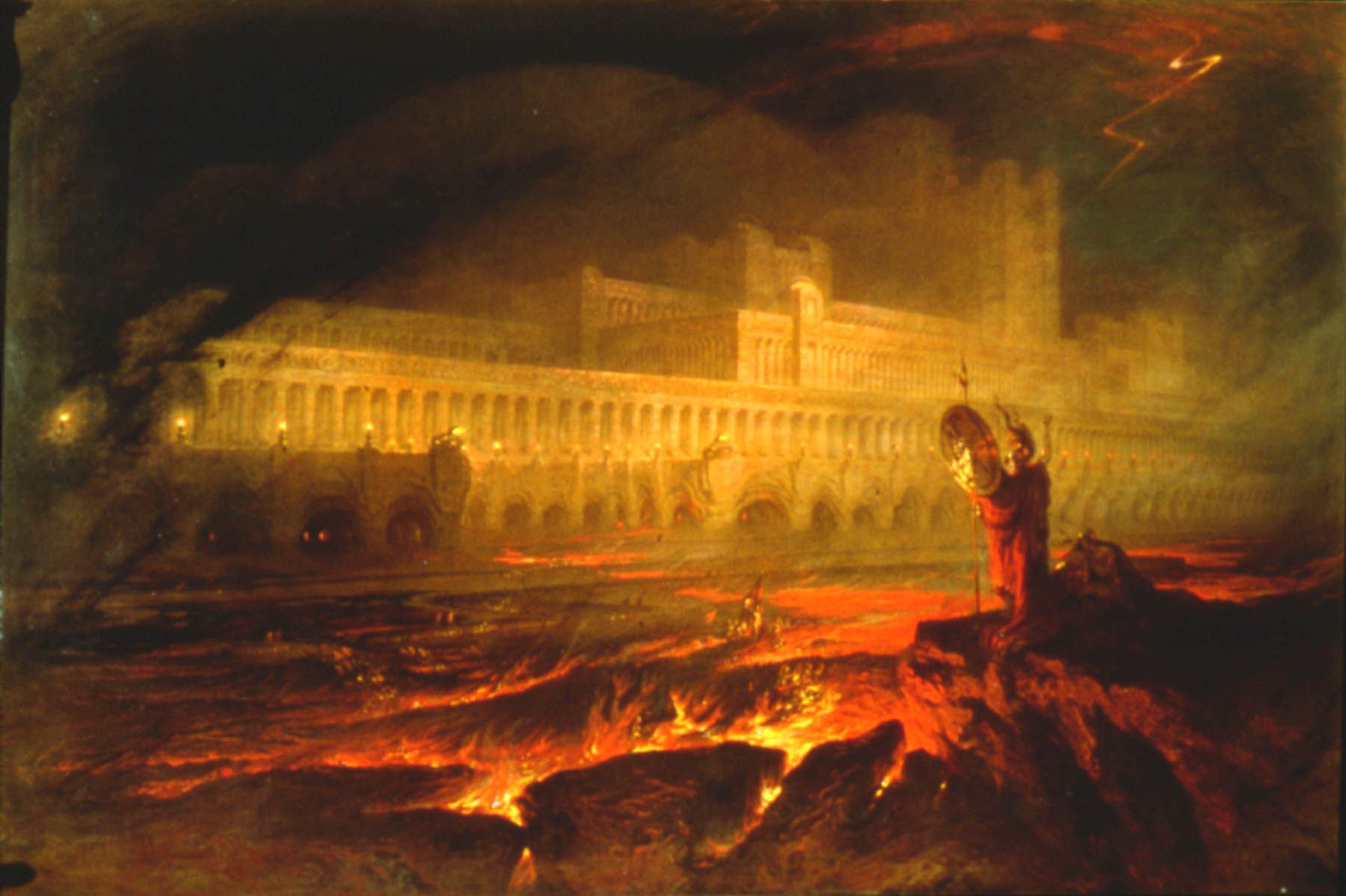
John Martin's 'Pandemonium'
The Bronze Age Collapse(ca. 1150 BC) saw the demise of the Mycenean kingdoms, the Hittite empire in Anatolia and Syria, the Egyptian empire in Syria and Canaan, and the mass destruction of scores of cities in the Middle East. Baillie writes (1999):
Sometimes near or in the twelfth century BC, allowing for flexibility in archaeological and ancient historical evidence, the whole fabric of ancient society appears to have crumbled. Some have suggested that in most of Britain there was upland abandonment, particularly severe in Scotland, followed by an upsurge in the construction of defensive sites. Around the Mediterranean there was an endless list of movements and collapses. Most interesting was the demise of the Mycenaean civilization in Greece with the ensuing four-century ‘Greek Dark Age’ which descended on the Mediterranean region. Here was an extremely dramatic decline where people had already argued for some sort of environmental ‘event’ involving a prolonged and highly regionalized drought. (p. 71)
The 1159 downturn in climate is commonly dated to the beginning of the end of the Twentieth Dynasty, the reign of Ramesses III: a time of drought, famine, political corruption, expensive wars and civil unrest. As Wikipedia puts it, “Something in the air prevented much sunlight from reaching the ground [HK: How’s that for cosmic symbolism?] and also arrested global tree growth for almost two full decades until 1140 BC. One proposed cause is the Hekla 3 eruption of the Hekla volcano in Iceland but the dating of this remains disputed.” Or comet dust/debris, perchance?
Historian John Van Seters, writing in 1966, before the impact of climate and catastrophe figured much into the analysis of these periods of history, had this to say on the earlier MB II/LB I transition:
The end of the Middle Bronze Age is clear and undisputed. Here the break is not a cultural one, for there is definite continuity in architecture, pottery, and art. The division is characterized by widespread destruction of a number of sites in southern Palestine and by the appearance of new pottery styles in addition to older forms. The destructions can best be understood as the activity of the Eighteenth Dynasty pharaohs and the date for the end of Middle Bronze would be about 1550 B.C. (The Hyksos [Wipf and Stock, 2010], p. 9)
Van Seters argues that this period coincides with the end of Hyksos rule/Second Intermediate Period, not the beginning, possibly giving us an anchor (1628 BC) with which to solidify an accurate chronology of the time, although Egyptian chronology is a mess when you actually dig into it. The Egyptian New Kingdom, which sprung up after the Hyksos fell, lasted 479 years according to historians, from 1550-1069 BC. (Incidentally, this is also the length of time traditionally given for the ‘Israelite Exodus’.) Perhaps not so coincidentally, the time between the two climatic downturns identified by Baillie is 469 years: 1628-1159 BC. This is also close to the time calculated between the falls of the Xia and Shang dynasties in China (anywhere from 496 to 554 years, depending on who you ask). Baillie devotes an appendix to this issue, and argues that the dates for the dynasties would be better matched to the periods mentioned, although this too is a contentious issue.
As for the EB IV/MB I transition (2100 BC), this period saw the beginning of the first ‘dark age’ or Intermediate Period in Egyptian history, for which relatively little evidence survives. Here’s what Van Seters has to say about it:
The coming of the MB I people into Transjordan does not, as in Palestine, represent an invasion and sudden destruction of the previous EB III civilization. It is instead an immigration and settling, for the most part, on previously uninhabited sites. … The first phase of the new immigration is often known as EB IV because it is contemporaneous with the last of the EB peoples of Palestine and Transjordan … The mixture of ceramic styles of EB IV and MB I cannot be easily distinguished stratigraphically in Transjordan … The decline of [EB IV/]MB I in Transjordan and the Negev is catastrophic. … In fact there is a general absence of sedentary life for several hundred years. Likewise in Palestine, MB I was very likely followed by a gap in settlement, but of a much shorter duration. (p. 13)
Summing up, the evidence for a cometary catastrophe ca. 1600 BC is fairly strong, at least according to Baillie. If the Cs are right about a 3,600-year cycle, we’re overdue another encounter. Even if they’re wrong about the cycle, the scientific record is showing that such encounters are anything but extraordinary. As the article quoted above stated, “At least five times during the last 6,000 years, major environmental calamities undermined civilizations around the world.” Those aren’t very good odds…
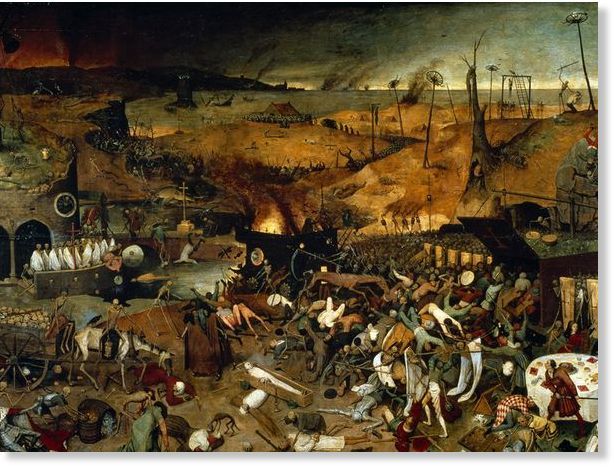
Hell on Earth, the nightmare depicted by Flemish painter Pieter Bruegel in his mid-16th-century 'The Triumph of Death' reflects the social upheaval and terror that followed the plague that devastated medieval Europe. Was there a cosmic connection?
Discover more from Cassiopaea
Subscribe to get the latest posts sent to your email.

